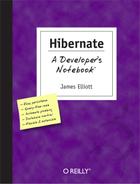1.2. Getting the HSQLDB Database Engine
Hibernate works with a great many relational databases; chances are, it will work with the one you are planning to use for your next project. We need to pick one to focus on in our examples, and luckily there's an obvious choice. The free, open source, 100% Java HSQLDB project is powerful enough that it forms the backing storage for several of our commercial software projects. Surprisingly, it's also incredibly self-contained and simple to install, so it's perfect to discuss here. (If you've heard of Hypersonic SQL, this is its current incarnation. Much of the Hibernate documentation uses the older name.)
Tip:
Don't panic if you end up at http://hsql.sourceforge.net/ and it seems like the project has been shutdown. That's the wrong address—it's talking about the predecessor to the current HSQLDB project. Use the address below to find the current version of the database engine.
1.2.1. Why do I care?
Examples based on a database that everyone can download and easily experiment with mean you won't have to translate any of the SQL dialects or operating system commands to work with your available databases (and may even mean you can save a day or two learning how to download, install, and configure one of the more typical database environments). Finally, if hsqldb i new to you, chances are good you'll be impressed and intrigued, and may well end up using it in your own projects. As it says on the project home page (at http://hsqldb.sourceforge.net):
hsqldb is a relational database engine written in Java, with a JDBC driver, supporting a rich subset of ANSI-92 SQL (BNF tree format). It offers a small (less than 160k), fast database engine which offers both in memory and disk based tables. Embedded and server modes are available. Additionally, it includes tools such as a minimal web server, in-memory query and management tools (can be run as applets), and a number of demonstration examples.
Go on, download HSQLDB. Heck, take two, they're small!
1.1.2. How do I do that?
Getting the database is simply a matter of visiting the project page at http://hsqldb.sourceforge.net" and clicking the link to download the current stable version. This will take you to a typical SourceForge downloads page with the current release highlighted. Pick your mirror and download the zip archive. There's nothing to install or configure; we'll show you how to use it shortly.
1.1.4. What about…
…MySQL, PostgreSQL, Oracle, DB2, Sybase, Informix, or some other common database? Don't worry, Hibernate can work with all these and others. We'll talk about how you specify "dialects" for different databases later on. And if you really want, you can try to figure out how to work with your favorite from the start, but it will mean extra work for you in following along with the examples, and you'll miss out on a great opportunity to discover HSQLDB.
1.2.2. Getting Hibernate
This doesn't need much motivation! You picked up this book because you wanted to learn how to use Hibernate.
1.2.3. How do I do that?
Go to the Hibernate home page, http://www.hibernate.org/, and click on the "Download" link. The Binary Releases section will tell you which version is recommended for downloading; follow that advice. Make a note of the version you want and proceed to the "Download: SourceForge" link. It takes you to a SourceForge downloads page. Scroll down until you find the recommended release version of Hibernate itself (which will look something like hibernate-2.x.y.zip or hibernate-2.x.y.tar.gz). Choose the archive format that is most convenient for you and download it.
Pick a place that is suitable for keeping such items around, and expand the archive. We will use part of it in the next step, and investigate more of it later on. You may also want to poke around in there some yourself.
While you're on the Hibernate downloads page, also pick up the Hibernate Extensions. They contain several useful tools which aren't necessary for an application running Hibernate, but are very helpful for developers creating such applications. We'll be using one to generate Java code for our first Hibernate experiment in the next chapter. This filename will look like hibernate-extensions-2.x.y.zip (it won't necessarily have the same version as Hibernate itself). Once again, pick your favorite archive format, download this file, and expand it next to where you put Hibernate.
